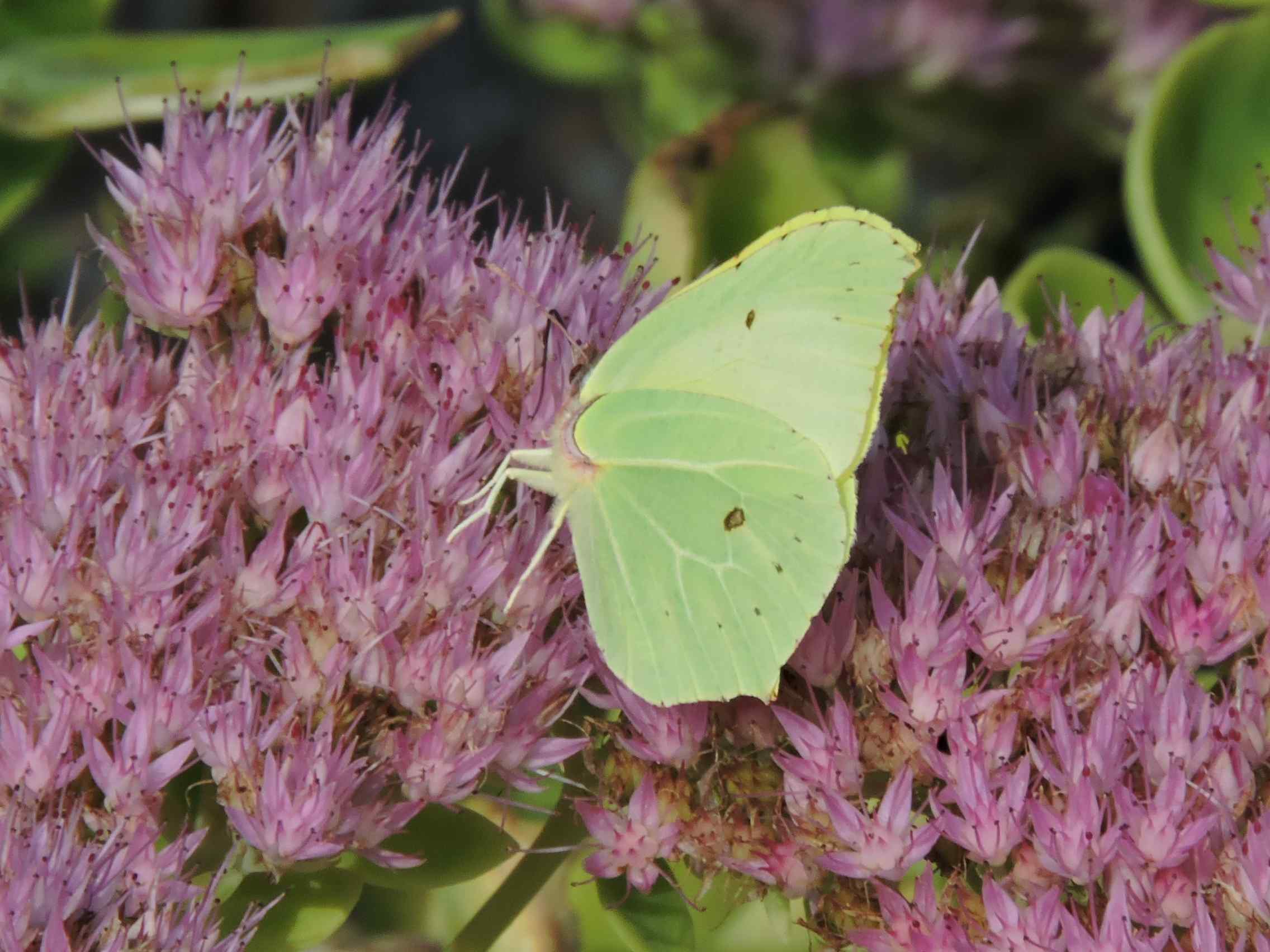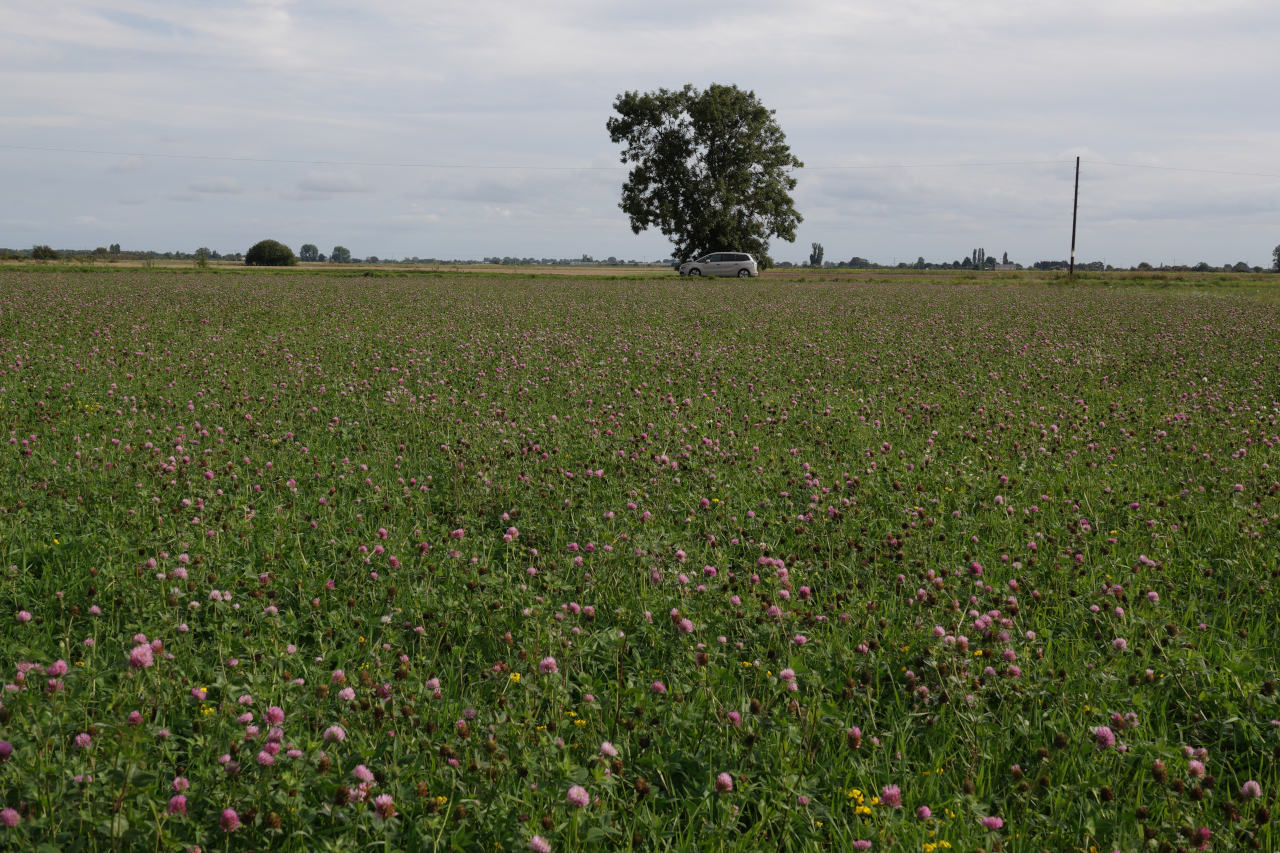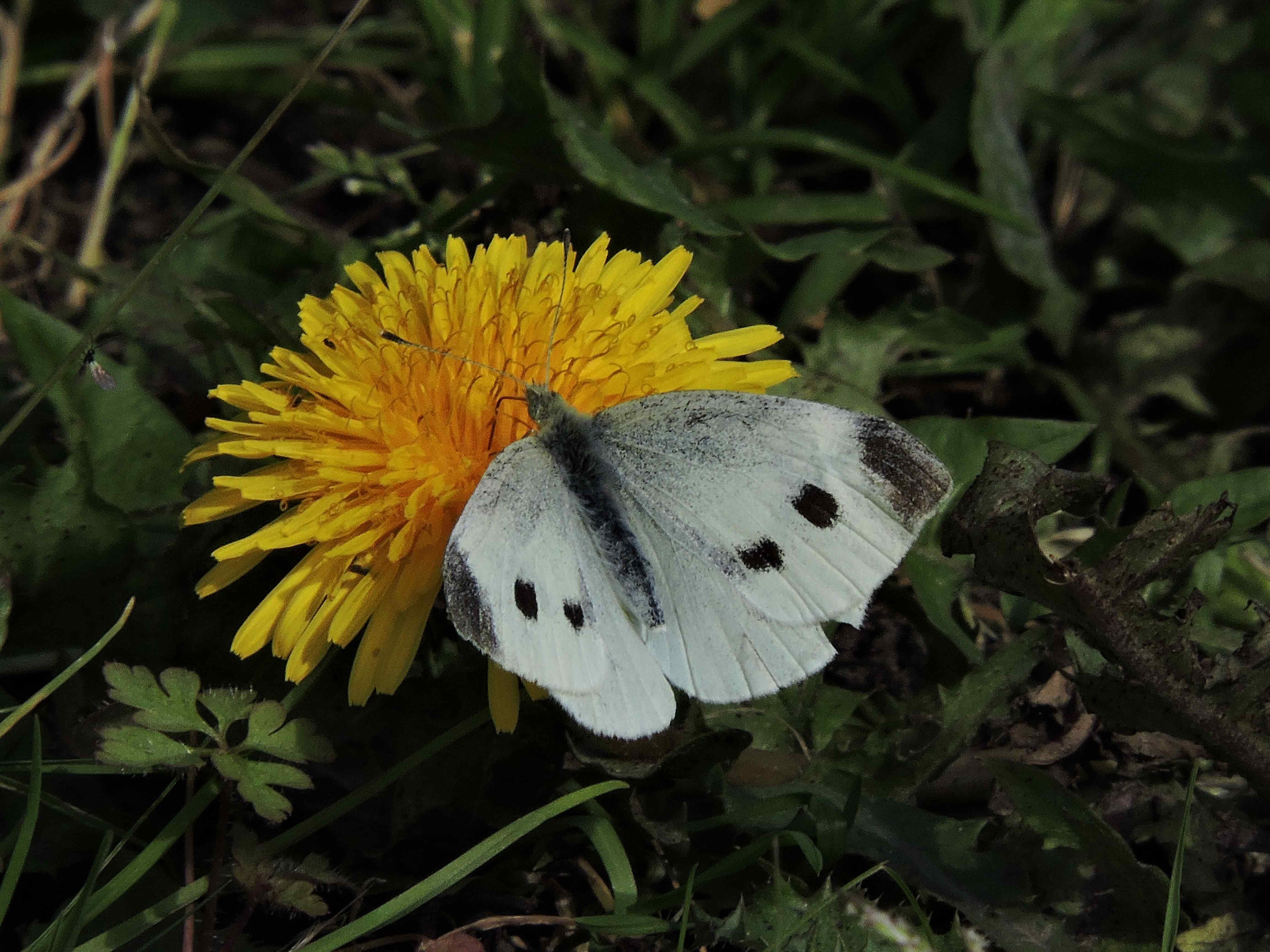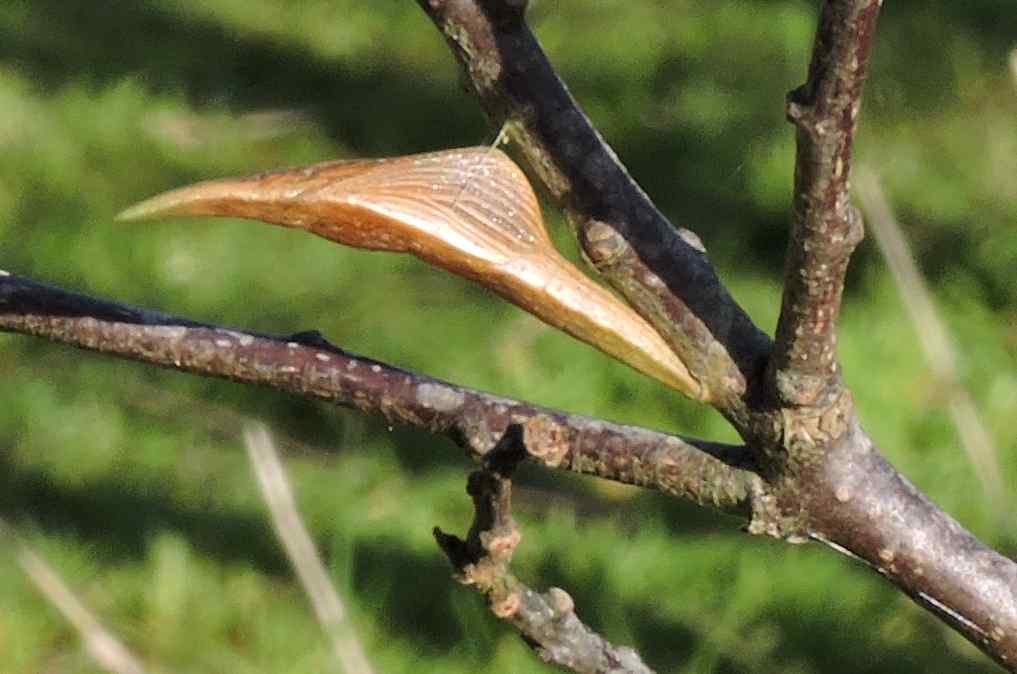Whites and Yellows
 Whites
Whites Yellows
Yellows
Family: PIERIDAE
This family includes the familiar 'Cabbage Whites' and their allies. Due to their larger size and conspicuous colouring, they are much more noticeable. They, and especially the Yellows move around more too, being in the more mobile categories of butterflies.
Clouded Yellow (Colias croceus)
 Clouded Yellow
Clouded Yellow
This is a quite common migrant most years in the south of England, but not so further north. To date there have only been four summers when it has actually visited our garden, although 2022 witnessed a phenomenal mass emergence in a neighbouring clover field. Due to its erratic migration this far north into Britain, it may be years before we see it here again. Even if the butterflies breed whilst here, the caterpillars cannot survive our winters. The butterflies are much more beautiful than can be appreciated from photos, because they rarely open their wings when settled, therefore their real beauty is only discerned in flight, a striking yellow and black combo! Around 10% of the females are a different 'form' known as helice, where the yellow upperside colour is replaced by white.
CURRENT STATUS: infrequent migrant - seen 1998, 2000, 2002, 2014, plus the nearby September 2022 mass emergence referred to above - see news pages 7.9.22 onwards for more detail.
LARVAL FOODPLANT: clover.
FAVOURED NECTAR PLANTS: buddleia; red clover; scabious; verbena bonariensis; knapweed; liatris spicata.
WHEN SEEN: early migrants in June and July, then their offspring and/or further migrants later in August and September.
SPECIALIST REQUIREMENTS: purely migratory - a guest species.
 The usual view of a Clouded Yellow settled, with wings closed.
The usual view of a Clouded Yellow settled, with wings closed. Male showing his upperside as he takes off from the flower.
Male showing his upperside as he takes off from the flower. The helice form of the female showing her upperside as she rejects the advances of a male.
The helice form of the female showing her upperside as she rejects the advances of a male. The 2022 clover field near us where all the action took place, sown with a clover - birds-foot trefoil - vetch mix as part of an environmental stewardship scheme.
The 2022 clover field near us where all the action took place, sown with a clover - birds-foot trefoil - vetch mix as part of an environmental stewardship scheme.
Brimstone (Gonepteryx rhamni)
 Male Brimstone
Male Brimstone Female Brimstone resting amongst alder buckthorn, its larval foodplant
Female Brimstone resting amongst alder buckthorn, its larval foodplant
The bright butter yellow is only present in the male, the female is a greenish-white colour, but in flight can easily be mistaken for a Large White.
 Open winged Brimstone
Open winged Brimstone
I am fascinated by the males in spring (their breeding season) when they tirelessly patrol the whole garden and beyond in search of females. It is a wonderful sight.
CURRENT STATUS: uncommon. Breeds on site but has yet to show in good numbers. Despite counting thirty seven larvae in 2017, and that was just the low level buckthorn branches, only five butterflies were seen that summer!
LARVAL FOODPLANTS: alder and purging buckthorn.
FAVOURED NECTAR PLANTS: buddleia; red campion; dame's-violet; honesty; broad bean; rose campion; scabious spp.; montbretia; hemp agrimony; fox-and-cubs; red phlox; clover; mallow.
WHEN SEEN: hibernate as adults, so can be seen as soon as the spring weather is warm enough, up until late June. The offspring fly from late July until entering hibernation, usually around September - October.
SPECIALIST REQUIREMENTS: a wealth of the foodplant if you want these wanderers to stay with you. Even then they may decide to wander off on their missions.
 Brimstone egg
Brimstone egg Brimstone larva
Brimstone larva
This is the longest living British butterfly, the adults living for almost a year including hibernation. They hibernate in evergreen bushes, bramble, or ivy, where they look like leaves themselves.
They breed in the spring only, and the new butterflies that emerge in the high summer wander extensively.
Large White (Pieris brassicae)
 The largest of the Whites, in fact one of the UK's largest butterflies
The largest of the Whites, in fact one of the UK's largest butterflies The female has additional black spotting, absent in the male
The female has additional black spotting, absent in the male
This, and the related Small White, are the two notorious 'Cabbage Whites'. These butterflies wander freely, looking for two things: nectar to keep them fuelled and brassica crops to lay their eggs on. Obviously all gardens have one or both, so these butterflies are very much at home in gardens. We do not actively encourage these two species, but in view of their mobility just mentioned and our garden being a haven for butterflies anyway, we get very good numbers of them.
CURRENT STATUS: very common visitor. We do not regularly grow brassicas in our garden - the butterfly often breeds on alternative foodplants grown for the encouragement of the Green-veined White and Orange Tip.
LARVAL FOODPLANTS: brassica crops. Also uses honesty, dame's-violet, and garlic mustard.
FAVOURED NECTAR PLANTS: buddleia; dame's-violet; verbena bonariensis; red campion; honesty; scabious; devil's-bit scabious; runner bean; marjoram; knapweed; thistles.
WHEN SEEN: April - June. July - October.
SPECIALIST REQUIREMENTS: none - a true pioneer species.
Small White (Pieris rapae)
 Male Small White
Male Small White Female Small White
Female Small White
CURRENT STATUS: very common, sometimes abundant visitor. We do not regularly grow brassicas in our garden - the butterfly breeds on alternative foodplants that occur in the garden.
LARVAL FOODPLANTS: brassica crops. Garlic mustard, horse radish, oil seed rape.
FAVOURED NECTAR PLANTS: buddleia; dame's-violet; verbena bonariensis; marjoram; honesty; scabious; devil's-bit scabious; aubretia; knapweed; thistles; bramble; privet; dandelion; ice plant; michaelmas daisy;
WHEN SEEN: April - June. July - October.
SPECIALIST REQUIREMENTS: none - a true pioneer species.
Green-veined White (Pieris napi)
 Compare the very noticeable veined underside of the Green-veined White to the more basic markings of the Small White underside
Compare the very noticeable veined underside of the Green-veined White to the more basic markings of the Small White underside Female Green-veined White
Female Green-veined White
Same sexual differences as for the two previous species. The underside markings are a clear distinction between this and the similar sized Small White - the veins of the wings being noticeably picked out in green, as its name suggests.
This is NOT a Cabbage White. Although the larvae of the two Cabbage Whites will eat the foodplants of the Green-veined, it never happens vice versa. These are true butterflies of the countryside, their caterpillars feeding mostly on wild plants.
CURRENT STATUS: very well established resident.
LARVAL FOODPLANTS: garlic mustard, cuckoo flower, honesty, dame's-violet, oil seed rape and related crucifers. NEVER brassica crops.
FAVOURED NECTAR PLANTS: buddleia; dame's-violet; marjoram; scabious; devil's-bit scabious; aubretia; honesty; bramble; privet; verbena bonariensis; knapweed; hemp agrimony.
WHEN SEEN: April - June. July - September.
SPECIALIST REQUIREMENTS: seemingly very happy here without any specific attention other than the provision of larval foodplants.
Orange Tip (Anthocharis cardamines)
 Male Orange Tip
Male Orange Tip Female Orange Tip
Female Orange Tip
This is the true harbinger of spring, from April onwards. Only the male has the distinctive orange tip to the forewings. To the novice, females could be mistaken for one of the other Whites, but the underside mottling is a sure give away. Unlike the other Whites, this butterfly is only seen in the spring. This is because the caterpillars eat the developing seed pods of the various foodplants, which are only available in the early months of the season, not the leaves as with the other species that are double brooded.
 Camouflage at its best. When settled with wings tightly closed on umbellifers and the like, the Orange Tip blends in perfectly with the background.
Camouflage at its best. When settled with wings tightly closed on umbellifers and the like, the Orange Tip blends in perfectly with the background.
CURRENT STATUS: very well established resident.
LARVAL FOODPLANTS: garlic mustard, cuckoo flower, honesty, dame's-violet, charlock, oil seed rape.
FAVOURED NECTAR PLANTS: dame's-violet; honesty; aubretia; red campion; dandelion; bluebell.
WHEN SEEN: April - June.
SPECIALIST REQUIREMENTS: untidiness!! Orange Tips provide two good examples of how a wildlife garden cannot be kept too tidy. Every picture tells a story:
 The larvae of the Orange Tip are equally well camouflaged , resembling seed pods of their larval foodplant, in this case dame's-violet. In ordinary gardens this and other plants would be cut back once the flowers had died. If we did that, we would lose the Orange Tips
The larvae of the Orange Tip are equally well camouflaged , resembling seed pods of their larval foodplant, in this case dame's-violet. In ordinary gardens this and other plants would be cut back once the flowers had died. If we did that, we would lose the Orange Tips Clearing up of dead stems and twigs in the hedgerows would also lead to disaster - the Orange Tip pupae spend many months in this dormant stage of metamorphosis from July, through the winter, until the butterflies hatch the following April or May. They attach themselves to these supports, which they mimic
Clearing up of dead stems and twigs in the hedgerows would also lead to disaster - the Orange Tip pupae spend many months in this dormant stage of metamorphosis from July, through the winter, until the butterflies hatch the following April or May. They attach themselves to these supports, which they mimic